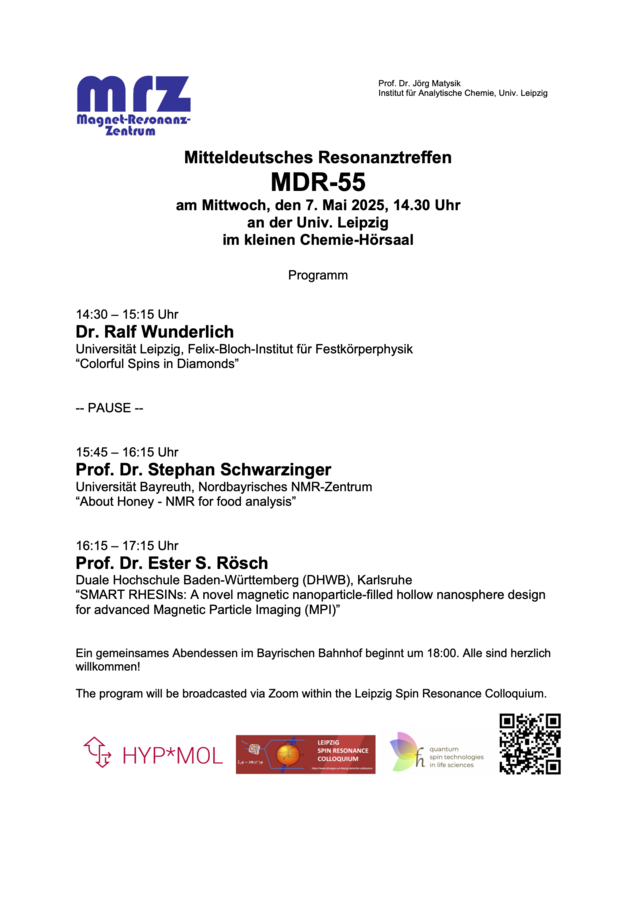Leipzig Spin Resonance Colloquium
LSR Colloquium
Current Program
Perfecting MRI imperfections
MRI provides excellent soft tissue contrast and has been the imaging modality of choice for in vivo neuroimaging. The surge in hardware, data acquisition, and image reconstruction development over the last decade has enabled the use of MRI to extract detailed structural and functional information of the brain in vivo at an unprecedented mesoscopic scale. At such a fine scale, various imaging imperfections arising from system hardware non-idealities, involuntary motions, and subtle physiological motions, such as from breathing, can end up being the main factors that limit actual achievable imaging resolution. This talk will describe various novel data acquisition and reconstruction techniques that we have developed to tackle these issues, to pave the way for rapid and robust in vivo MRI at the finest scales.
Profile
New Horizons with Parahydrogen-Induced Polarization: Live Tracking of Hyperpolarization Dynamics and Solid State Spin Diffusion
In this talk I will cover some important new advances in PHIP research. Firstly, the use of low-field NMR to track adiabatic transitions in real-time, which offers a 'live' view into polarization processes, in contrast to the typical pulse-acquire approach to NMR. Secondly, I will briefly discuss distant dipolar fields and how high sample magnetization limits polarization transfer efficiency. Finally, the use of solid-state spin diffusion as a new approach for polarizing molecules using PHIP.
Nanoscale covariance magnetometry with diamond quantum sensors
Correlated phenomena play a central role in condensed matter physics, but in many cases there are no tools available that allow for measurements of correlations at the relevant length scales (nanometers - microns). We have recently demonstrated that nitrogen vacancy (NV) centers in diamond can be used as point sensors for measuring two-point magnetic field correlators [1]. NV centers are atom-scale defects that can be used to sense magnetic fields with high sensitivity and spatial resolution. Typically, the magnetic field is measured by averaging sequential measurements of single NV centers, or by spatial averaging over ensembles of many NV centers, which provides mean values that contain no nonlocal information about the relationship between two points separated in space or time. We recently proposed and implemented a sensing modality whereby two or more NV centers are measured simultaneously, from which we extract temporal and spatial correlations in their signals that would otherwise be inaccessible. We demonstrate measurements of correlated applied noise using spin-to-charge readout of two NV centers and implement a spectral reconstruction protocol for disentangling local and nonlocal noise sources. More recently, we have shown how to extend these measurements below the diffraction limit and using entangled pairs of NV centers, and we have also demonstrated massively multiplexed nanoscale sensing measurements with hundreds of NV centers in parallel []. This novel quantum sensing platform will allow us to measure new physical quantities that are otherwise inaccessible with current tools, particularly in condensed matter systems where two-point correlators can be used to characterize charge transport, magnetism, and non-equilibrium dynamics.
[1] "Nanoscale covariance magnetometry with diamond quantum sensors," J. Rovny, Z. Yuan, M. Fitzpatrick, A. I. Abdalla, L. Futamura, C. Fox, M. C. Cambria, S. Kolkowitz, N. P. de Leon, Science 378, 6626 1301-1305 (2022).
[2] "Massively multiplexed nanoscale magnetometry with diamond quantum sensors," K.H. Cheng, Z. Kazi, J. Rovny, B. Zhang, L. Nassar, J. D. Thompson, N. P. de Leon, arXiv:2408.11666.
Profile
MD simulations of NMR relaxation and diffusion of fluids
Program Archive
LSRC coordinator: Dr. Evgeniya Kirillina, contact email






